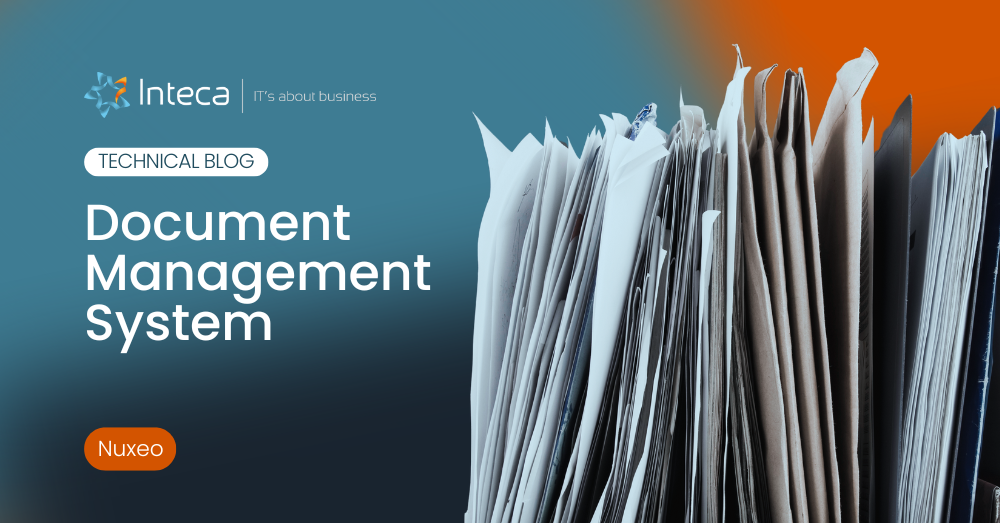A well-executed Document Management System implementation is crucial because of the positive impact it may have on a company’s ability to keep track of its paperwork. This has the potential to improve workflow, reduce costs, enhance version control and make sure that relevant data is readily available to those who need it. When properly designed, a doc management system can also assist a business in meeting legal and privacy standards. If your company’s paperwork order is critical to its growth, this article will bring you information on how the implementation of a Document Management System should be done right.
Big businesses have long been struggling to make sense of the mountain of paper documents, digital files, databases, and internal websites that make up their corporate archives. Nowadays, many companies managed to eliminate the need for paper-based records of this kind, but their initial lack of expertise in content management systems, coupled with a fear of data loss, has resulted in a hybrid system in which both paper and digital records coexist.
After understanding they need to create a system to file and retrieve documents that made sense for both business needs and long-term planning, companies developed an on-premise, cloud-based Document Management System. But what is the next step? A simple answer: it’s not a matter of if, but how, you put it into action.
Document Management System is a must-have
A Document Management System (DMS) is a software program that allows users to store, manage, and track electronic documents and the associated processes. It allows users to store documents in a central repository, logically organize them, and easily access them. An example of such a solution is Nuxeo document management. A DMS can help businesses save time and money by streamlining document management processes, providing secure storage for documents, and allowing for collaboration and sharing of documents.
One can summarize the main advantages of implementing management solutions for a large company as follows: company information can be shared efficiently and safely, regardless of where it is physically located; the overall knowledge of the organization is preserved because the data flows efficiently and fluidly, and uncertainty about the available data is resolved when managing different versions of documents.
Document Management Implementation Plan
A document management system is a relatively new specialty in the digital industry, and as a result, most companies lack established protocols for handling this task. A document management system can be set up quickly and efficiently. This means that the first step in implementing document management is to conduct an analysis.
Analysis Process for a Document Management System
The analysis is important to understand the current document management system to determine its features and capabilities and any potential limitations. This will help to identify areas where improvement is needed. The next step is to assess the document management requirements of the business, including identifying the types of documents that need to be managed, the processes associated with them, and any security requirements.
After assessing the document management requirements, it is important to assess the current system’s capabilities and identify any areas that need improvement. All these activities can be carried out using platform managed services. This includes evaluating the system’s ability to store, organize, and track documents, as well as its ability to provide secure access to documents.
Once the current system has been assessed, it is important to evaluate potential vendors to find the one that best fits the needs of the business. This includes researching different vendors’ offerings and comparing their features and capabilities. After selecting a vendor, it is important to evaluate the software they offer to ensure it meets the requirements of the business. This includes assessing features such as user interface, performance, scalability, security, cost, and support.
Several considerations should accompany your needs analysis:
- How many files does the system need to hold?
Take into account not just the total quantity of papers, but also the yearly growth rate of the document collection. The amount of storage space, hardware requirements, and overall system cost are all determined by the answers to these questions.
- How many users will be accessing the system simultaneously?
Initial software expenses, needed licensing, and server size are all determined by this factor.
- Is it necessary to allow public access to the system, and what departments will be using it?
That’s what’ll tell you what kinds of features and safeguards to include.
- What issues must be addressed at the company level?
This is what defines which features of a document management system are mandatory and which are discretionary. It’s also useful for figuring out if any add-ons or tweaks are going to be required.
- Do you have problems with regulatory compliance at your company?
If that’s the case, the DMS you’re using should include features that ensure you’re always in compliance.
- Does it require integration with other systems?
Due to the complexity of document and records management systems, it is important to address any integration issues before making a financial commitment.
- Do you want a ready-made solution or a bespoke one?
In turn, this establishes the scope of required services including consultation, set-up, instruction, customization, and maintenance.
- How would you describe the current network setup?
Is it going to be maintained as-is or enhanced in the future? Based on this, decisions about network capacity, system setup, and workstation upgrades can be made.
What does the analysis involve?
To do a needs analysis quickly and effectively, it’s best to conduct what is often known as a process analysis in each department. Process analysis is based on the premise that your regular tasks can be decomposed into a set of standardized procedures. The decisions taken at the outset of a business process always determine where that process goes from there. Since papers are a crucial part of many business processes, doing a process analysis will help you immensely as you get ready for implementation. This is what an in-depth process analysis entails:
Relate typical routines to organizational steps.
Take a look at the things you do on a regular basis for your department. Find out where they all start and what choices you have to make to get there.
Make sure to draw out and record all of your procedures.
Many regard flowchart representations of process diagrams to be the most comprehensible. Flowcharts are the most intuitive method for representing processes graphically, as they make it easy to see the context within which decisions are made and the range of outcomes that can result. After creating a flowchart, you should write out the specifics of what occurs at each stage.
Locate where things aren’t working as they should.
Once you’ve documented your processes, you may begin the analysis phase, which involves looking for places where things go wrong. Which of these most commonly occurs? Which parts of the procedure are taking too long? Is there too much red tape involved? Are there possible dead ends in the procedures that prevent them from being resolved? Finding where your processes are failing is the first step toward fixing them. You won’t have much evidence to support your requirement for a document management system if you can’t uncover any problems.
Implementation Plan a Document Management System
Once the analysis process is complete, it is time to create a document management solution based on the requirements identified during the analysis process. This includes selecting the appropriate software, configuring it according to the business’s needs, and testing it before going live. The next step is to develop strategies for managing documents in the DMS. This includes identifying roles and responsibilities for users, setting up access control procedures for sensitive documents, developing data retention policies, and establishing guidelines for document storage.
After selecting a vendor, it is important to evaluate their services to ensure they meet the business’s needs. This includes evaluating their customer service and support capabilities, as well as their pricing structure. The next step is to develop an implementation plan for the DMS. This includes creating a timeline for rollout, and retrieval, as well as training users on how to use the system, and setting up processes for monitoring usage and performance.
Once the system has been implemented, it is important to ensure that it is working properly and that users are familiar with how to use it. This includes setting up processes for tracking usage statistics and identifying areas where improvements can be made, as well as how to automate the cycle.
Developing Implementation Plan a Document Management System
Careful planning is one of the most crucial parts of a successful implementation, and this planning must be developed into an implementation plan.
The first dollar should not be spent on a project without proper planning. Documenting the project’s scope, system requirements, schedule, business case, and technical environment in great detail before beginning the project greatly increases the likelihood of its success. Despite how obvious it may seem, these basics are often overlooked until after a project has already begun. The document management expert you hire should help you develop a strategy for putting that strategy into action. If you try to implement a document management system internally without the help of experts, you may overlook crucial details that could have a significant impact on the project’s success and budget.
Making a strategy for carrying it out
As the first step in any installation, the software provider should do a site study to establish where components should be placed and whether or not there will be any connectivity issues. Connecting and configuring the hardware, as well as installing any required software and drivers, is known as “installation.” Hardware functionality and network connectivity can only be guaranteed through rigorous testing.
After the hardware has been thoroughly tested, the following step is to set up the software. Document management software is installed on the document management server and any other required workstations at this stage. It needs to be tried out to make sure it works. Most of the time, the software provider will handle these responsibilities, but the organization’s IT department will play an integral role in the process.
You’ll find a worksheet at the end of this manual that’s meant to help you map out your strategy for putting it into action. Making a smooth transition to your new system easier is possible with careful planning of the implementation process. A well-thought-out implementation strategy can also aid in determining who on staff will play what roles and how the new system will fit into existing procedures.
Provision of Help and Upkeep of a Document Management System
Management of documents requires upkeep much like any other mechanical device. It is important for businesses to examine the software vendor’s customer service. The vendor should provide a range of support options, from occasional remote assistance to scheduled on-site maintenance. How much help your company requires is affected by the following variables:
- Information technology (IT) staff familiarity with document management
- Internet availability
- Concurrent modifications to the organization’s computer network or infrastructure
- Employee turnover rate
- The size of the system purchased
- The proposed level of system usage
Some examples of forms of assistance are listed below.
- Free updates,
- Toll-free helpline,
- Online community,
- Remote desktop access,
- and FTP downloads of patches for existing software.
Hardware support consists of the following:
- Regularly released technical bulletins or newsletters
- On-site maintenance visits
- Advanced and/or additional training sessions
Your business should only buy servers, storage devices, and workstations from reputable vendors who also have stellar service and support records. There will be less downtime and more constant, reliable operation, but the upfront cost may be higher.
Benefits of Implementing a Document Management System
There are several benefits to implementing a DMS. It can help a business improve efficiency and productivity, reduce costs associated with document management, and enable secure storage and sharing of documents. Additionally, it can help ensure regulatory compliance by providing access control for sensitive information and an audit trail for all document-related activities.
Conclusion
A Document Management System can help businesses improve efficiency and productivity by streamlining document management processes, providing secure storage for documents, and allowing for collaboration and sharing of documents.
An effective analysis and implementation plan for a Document Management System requires assessing the current system’s capabilities and requirements, evaluating potential vendors and software solutions, developing strategies for managing documents in the DMS, and establishing successful document management processes.
With an effective analysis and implementation plan in place, businesses can ensure that their document management systems are working properly and efficiently.




